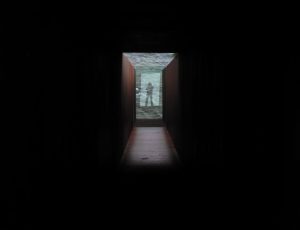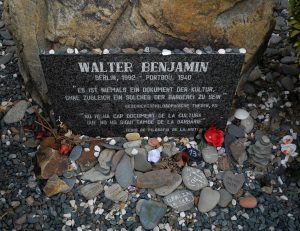Flight to the end of the road not a passage to freedom: in memory of Walter Benjamin
Tanja Miller
 It has become a common trope to describe the current movement of people towards safety in Europe or other places as the biggest such movement since WW II. It thus seems pertinent to remember one of the poignant journeys of that time, the flight of German philosopher Walter Benjamin across the Pyrenees from France to Spain in 1940.
It has become a common trope to describe the current movement of people towards safety in Europe or other places as the biggest such movement since WW II. It thus seems pertinent to remember one of the poignant journeys of that time, the flight of German philosopher Walter Benjamin across the Pyrenees from France to Spain in 1940.
What is now a hiking trail, 17 kilometres in length and with 600 metres difference in altitude to overcome, was then one of the last passages to freedom or so Benjamin hoped. Born in Berlin in 1892, philosopher, writer, Jew, and communist sympathizer, Benjamin first had to leave in 1933 when the Nazis came to power and went into exile to Paris. But by 1940 Paris was de-facto under Nazi occupation and not a safe place any longer.
Benjamin thus travelled to Banyuls-sur-Mer, on the French border with Spain, from where one could reach Portbou on the Spanish side. Even though Spain was ruled by the Spanish version of fascism under Franco, it was still possible to obtain a visa to the USA there. And that was Benjamins plan: to travel from Portbou first to Lisbon and then board a ship to the USA and to freedom, finally. He was to travel on paths used by local smugglers but also by Spanish republican fighters and international brigades in the Spanish civil war who had fled from Spain to France in the opposite direction.
The people smugglers at the time were people like Lisa and Hans Fittko, both refugees from the Nazis themselves, who then lived in Banyuls and helped others in need to make it to Spain. Benjamin and his small group were in fact the first refugees guided by Lisa. Benjamin and his fellow refugees eventually made it to Portbou. Because they did not
have an exit stamp from the French side, however, Spanish border guards put them into a small hotel but threatened to send them back to France the next day. Benjamin took the threat seriously and poisoned himself during the night. He died on 27 September 1940. Those who travelled with him were subsequently allowed to continue their journey thus one could say his sacrifice became their salvation.
For those who walk the trail today, in Portbou the journey can be brought to an end in two different ways: The first is a visit to Benjamins grave in the local cemetery. The second is a visit to the monument erected in 1994 by Israeli artist Dani Caravan in order to celebrate Benjamins memory. Not far from the cemetery, it consists of a walled-in iron staircase
that ends high above the sea with a glass wall. Walking the staircase to the end allows a  view to the far horizon, and invites the visitor to imagine freedoms and dreams of any kind. But one cannot pass through the glass, so the only route forwards is to turn back. The installation is called passages and is a fitting memorial to the memory of a great philosopher whose life was cut short by a brutal political regime, and whose last manuscript was almost carried to freedom but has since been lost.
view to the far horizon, and invites the visitor to imagine freedoms and dreams of any kind. But one cannot pass through the glass, so the only route forwards is to turn back. The installation is called passages and is a fitting memorial to the memory of a great philosopher whose life was cut short by a brutal political regime, and whose last manuscript was almost carried to freedom but has since been lost.
It also makes one think about the many lives lost on our shores in 2015, many anonymous and some in the limelight. I thus wish to dedicate my walk tracing Benjamins journey to all of them to their different hopes and aspirations. May they eventually receive the hospitality that was denied to Benjamin, and may we, the citizens of Europe, not forget the values that are at the core of the European project: freedom, security and justice without internal frontiers. Each new fence that is being erected at any European border, each train station or port that is being blocked to those without proper papers, and each asylum accommodation that goes up in flames, are betraying not only European ideals but also those who seek sanctuary. Those who like Benjamin 75 years ago longed for freedom.
Read a longer version of this blog with multiple photographs here



0 Comments